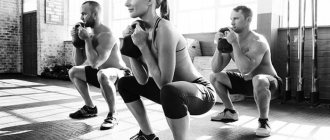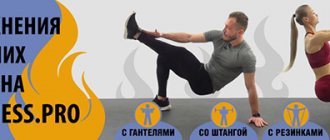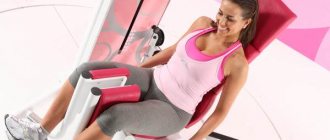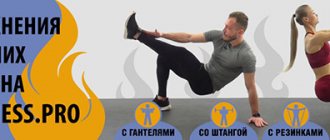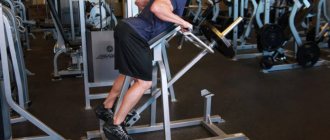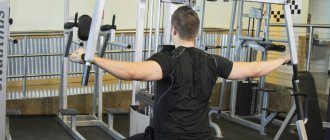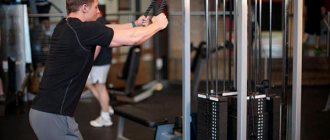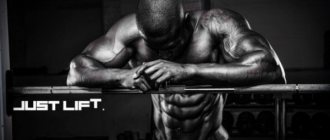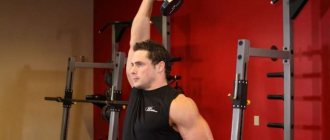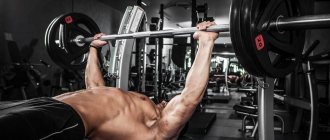The benefits and harms of overhead presses
This exercise has one advantage - a high load on the middle part of the deltoids. However, there are many different exercises that are much safer than this option.
The overhead bench press has many more disadvantages:
- Firstly, due to the unnatural position of the shoulder joints, the joint capsule can be injured.
- Secondly, as in other vertical presses, there is a load on the spinal column.
- There is also a high risk of spraining the ligaments.
- Another disadvantage is working with light weight. Of course, it is possible to place as many weighting discs as you like, however, in this case, injury is guaranteed!
- The exercise is strictly not recommended for people who have injuries such as hernia or protrusion of intervertebral discs, and the exercise is also contraindicated for those who have osteochondrosis.
Variations
There are several variations of this exercise, each of which has its own characteristics:
- Standing Overhead Press. Its positive qualities are that the compressive load on the spine acts only on one side. In addition, when the body is in a natural position, it is easier for it to absorb the load through the lower limbs. When performing the exercise while standing and feeling that the selected weight is too heavy for you or that you do not have enough strength to make a new jerk with your arms, you have the opportunity to drop the projectile to the floor and bounce off it. This possibility eliminates the presence of a person required for insurance.
- Seated press. This variation allows you to perform the exercise with a large weight of the barbell, since there is no need to maintain balance when lifting the load. Although in this case the presence of a belay person is provided, it will be much easier for him to cope with his task, and the athlete will be able to perform the exercise to the limit.
- Smith machine press. In the simulator, the barbell is fixed between the guides, therefore, when performing a bench press, the projectile will always fall to one point, which means that the likelihood of injuring the shoulder will be minimal. In addition, you don’t need a belay person, and if suddenly a projectile accidentally crushes you, you can fix it and get out. But there is one drawback: stabilizer muscles do not work in this variation.
Did you know? The brilliant idea of creating a power machine (Smith machine) came to the head of bodybuilder Jack Lalane. But, unfortunately, he did not take care of the paper part of his project, so the idea was intercepted by a man named Smith, who managed to accompany the simulator with the necessary technical documentation and issue a patent.
What muscles work in the overhead press?
The overhead barbell press is aimed at developing the middle bundles of the deltoid muscles. But the work also involves the posterior deltoids, trapezius muscles and triceps.
What and how to do?
After assessing all the risks, you can proceed directly to the technology. To perform the exercise you will need racks and a barbell with a load. We will perform the bench press while standing.
The sequence of actions is as follows:
- place the barbell on vertical racks and load it with the required weight. Then sit under the bar and move it slightly below the neck area. Now lift the barbell and move a little away from the racks (1-2 meters). Then take a stable position and straighten your back. This position is the starting position;
- lifting the projectile should be performed exclusively while exhaling. Therefore, take a full breath of air, gradually release it and lift the load. At the top point, stop and wait 1-2 seconds. After this, begin to smoothly lower the projectile behind your head, while inhaling;
- repeat the exercise as many times as necessary.
Seated overhead press technique
This option is much safer than the standing press, provided that the bench has a back on which you must lean your elbows. The sitting overhead bench press is suitable for those athletes who have problems with the spine. This exercise is best done with support. Alone, the overhead press can only be done in a Smith machine, but more on that later.
- First you need to set the angle of the back of the bench. It is 90 degrees.
- After sitting on the bench, the athlete must remove the barbell from its mountings. The placement of the hands on the bar is average (slightly wider than shoulder width). Elbows should form a right angle. Don't forget about arching your lower back.
- The first approach is not even a warm-up, but a trial one, best done with an empty bar. Please note that you need to increase the weight of the sports equipment little by little.
- Movements are performed smoothly, without jerking. At the top point of the amplitude, there is no need to fully extend your elbows.
- The lowest point of amplitude is located at the level of the back of the head. If you lower the bar as low as possible, the trapezius muscles will be more involved.
- Inhalation is done while lowering the bar, and lifting is done while exhaling.
Tips and tricks
The overhead press puts a lot of stress on the shoulder area, and with the slightest incorrect movement there is a very high probability of injury due to the large weight of the apparatus, therefore, in order to protect yourself, you need to know safety precautions and common mistakes when performing the exercise.
Did you know? The first to create a collapsible barbell were the Germans. This happened in the middle of the 19th century. V. F. Kraevsky, the founder of the Russian school of athletics, modified and improved the German barbell. It now has three markings for different lifting options and new discs weighing 2-10 pounds.
Safety regulations
Safety recommendations:
- always stretch your shoulder joints;
- start with an empty bar press (warm-up), then set the desired weight;
- the barbell is lifted not due to inertia, but due to the work of the deltoid muscles;
- keep your body straight, do not arch your back;
- for safety, do not perform bench presses with a large range of motion;
- if you are a beginner athlete or are working on building muscles, secure your lower back with a special belt;
- if you want to try to push yourself to the limit, ask someone to insure you;
- Between standing and sitting variations, give preference to standing so that you have the opportunity to drop the projectile.
Common mistakes made by newbies
Frequent mistakes of novice athletes:
- Press a heavy weight without warming up. Causes muscle injuries, sprains and inflammation.
- Jerky movement. Muscles get tired faster, and there is a chance of injury.
- Bowed head. The body bends behind it, which reduces the effectiveness of the exercise and loses balance.
- Large curve of the lumbar area. Causes spinal injuries.
- No tension in the abdominal muscles. Because of this, when the bar moves to the top point, the body can easily lose balance.
- Invalid starting position. If you do not properly arch the shoulder area, chest and lower back, other muscles in the shoulder area come into play.
Nuances and tricks of implementation
Features and recommendations for the overhead press:
- During the exercise, always keep the apparatus suspended. Don't let it rest on your shoulders;
- In order not to experience discomfort while performing the bench press, it is necessary that the shoulder area has some flexibility. If you feel pain during exercise, change the exercise to a similar one;
Important! A similar exercise could be the dumbbell press. In this case, the shoulders are less loaded, and due to the greater range of motion, the muscles are better stretched.
- It is better for beginners to practice their technique on a Smith machine. Variations are allowed with it both standing and sitting;
- the weight should be such that you can perform at least 8 presses;
- always keep your back straight;
- Elbows should move in a vertical plane. There is no need to tilt them forward or pull them back;
- extension of the arms should be smooth, and the pace of the exercise should be constant;
- keep your head straight and look ahead. Turning and tilting the head can easily cause loss of balance;
- optimal training schedule: once a week for two months.
Standing overhead press technique
This version of the overhead barbell press is suitable for experienced athletes who do not have problems with the spine.
There are two options for positioning your feet.
- The first is when the feet are shoulder-width apart;
- and the second, when one leg is in front and the other slightly behind for better stability.
The remaining recommendations and technical aspects are identical to the seated overhead press.
Why are deltoid muscles easily damaged?
The deltoid muscle of the shoulder consists of three bundles: frontal (anterior), lateral (posterior) and medial (middle). The front one is responsible for raising the arm forward, the back one is necessary for moving the limb back, and the middle one brings the forearm perpendicular to the axis of the spine, ensuring a safe lifting of the weight above the head. It is the middle delta that is loaded the most.
Why is this exercise not recommended for beginners? The fact is that novice athletes often cannot sensibly assess their strength: they take on huge weights, do more approaches, or are in a hurry to complete them. The result is injury to the shoulder joint and muscle strain. Beginners want to pump up faster and achieve a beautiful body, professionals already know that this approach will only lead to serious consequences. The delta cannot be developed until muscle mass is gained. In addition, the neuromuscular connection that is formed by following the technique is important.
Smith Overhead Press Technique
This option is best for those new to the gym and those whose fitness level is not yet good enough for overhead presses with free weights. This exercise has many advantages over other options.
- The Smith machine allows you to increase the working weight and perform the exercise without the support of a partner.
- The weight can be fixed at any point in the amplitude.
- Also, thanks to a more isolated press due to the movement of the bar strictly along the guides, the beginner will better work the target muscles.
The technique of performing an overhead press in a Smith machine is identical to the option while sitting on a bench.
Technical errors
Wrong trajectory
Some people manage to make this movement into a parody of the bench press. They press straight up at the highest point, pushing the barbell away from the body. This turns out to be a rather traumatic variation for the shoulders, which, as the weight increases, also becomes a cause of falls. Another trajectory error is placing the barbell sharply behind the head; this option is not acceptable because it contributes to unnatural overload of the cervical spine. The third trajectory error is the “nose press,” that is, performing the exercise at half the amplitude.
A hodgepodge of styles and exercises
Some athletes confuse this movement with the barbell overhead press due to technique. They do not press their forearms to the body, but do all the work by pushing the weight away from themselves and moving it behind the head. In this case, the elbows are spread to the sides, and the shoulders at the start are parallel to the floor. Everything would be fine if this particular initial position did not cause subacromial syndrome. Using this technique is fraught with joint pain.
Big ego
Huge weights lifted up look cool. But then treating inflammation of the ligaments and muscle tears is not at all as great. Working weights should be increased only when the movement technique allows them to be increased. Everything else is still superfluous.
Engaging your legs, back, and core
Some athletes, instead of bench presses, perform a half-push, a push-up, anything to push the weight with their legs. If you can’t squeeze the barbell smoothly with your hands, you should simply reduce the weight of the weight. It is not necessary to work with the help of the body and legs.
Heel-to-toe rolls
Many people find it difficult to hold weight without losing balance during exercise. Such people should try to carefully maintain their balance by placing their weight in the middle of the arch of the foot. If this doesn’t work out and all you can do is roll, you should switch to a seated press and simultaneously work on developing the muscles of your legs and core.
Excessive training volume
This is common for all beginners. It seems to them that the program is for hacks, and they train less than everyone else in the gym. So the person begins to perform all the approaches that, in principle, he can perform. The volume increases significantly, but the intensity stops growing. The athlete experiences pain in his ligaments and joints, he does not get stronger, and his training simply becomes another attempt to overcome himself. Over time, cumulative injuries appear, and the person refuses to exercise.
Lack of mobility in joints
Sometimes they write that movement cannot be performed only with arthrosis and osteochondrosis, but the problem is that a completely healthy person may be unable to make a movement of exactly this amplitude due to “office posture,” that is, weakness of the back muscles when the trapezius and pectoral muscles are overloaded. Over time, as your back strengthens, you will be able to lift weights overhead more effectively. Until this point, it is recommended to work with dumbbells.
The military press is a heavy compound exercise. But the norm for an amateur is to lift about half of his weight in this movement; there is no need to force things. If a person cannot lift more weight without pain, progress must be taken gradually, and be sure to actively engage in injury prevention.
The exercise should be included in your training on a regular basis, but it is better not to train your shoulders more than 2 times a week if you are a beginner, and try not to overload them even if you are an experienced athlete. It makes sense to perform either a heavy bench press or a heavy standing press, rather than constantly doing both heavy. Try to work efficiently, and you will always be able to train effectively.
